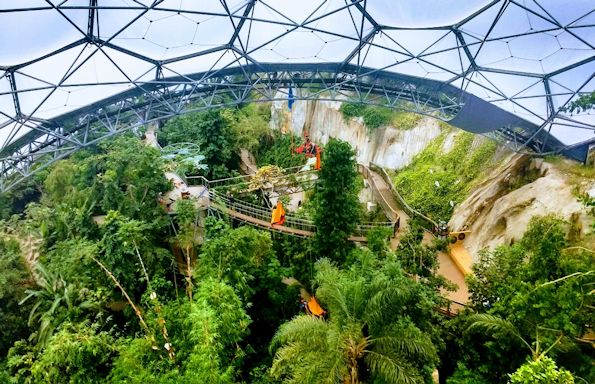
Stephanie Law is a PhD student in the Department of Earth, Ocean and Ecological Sciences. Her research project ‘Vertical stratification of ants in tropical rainforests’ is supported by the University and the Natural History Museum in London.
“Two months after returning from field work in Borneo and the hot, humid rainforest already feels like a distant memory. So when the opportunity arose to spend the night in the world’s largest enclosed rainforest at Eden, I jumped at the chance.
On June 24th the Eden project was home to The Big Canopy Campout. This was an international event to raise funds for the World Land Trust to buy a piece of rainforest along the Kinabatangan River in Borneo.
As the doors closed to the public a team of rope access technicians began rigging the rainforest biome with portaledges. Ordinarily used for nights spent on a rock face these portaledges were instead suspended from the ceiling, hung above and within the canopy.
Once the sun set and darkness had crept into the biome these hanging tents became illuminated by torches making for a spectacular scene in this iconic structure. With the rope access team sleeping in the arboreal tents, hammocks were strung along the canopy walkway to complete the camp over so all campers could rock themselves to sleep.
Although the Eden project specialises in plants the biome is home to some accidental inhabitants in this unusual tropical habitat. Blackbirds and Robins can be spotted alongside the more exotic Roul-roul partridge and White’s tree frog. With the path lights reflected in the hexagonal panels of the biome, it began to resonate as any other camping night under the stars.
This was truly an international event. Campers spent the night in trees from as far as New Zealand to Nicaragua. Sharing photos and videos of some epic nights spent in tree tops in weather conditions from glorious sunshine in Canada to the wind and rain in Stornoway.
The Big Canopy Campout organiser John Pike is already planning this to be an annual event for charitable forestry causes. This inaugural event was in aid of saving the Kinabatangan.
The Kinabatangan River is the longest in Sabah, North Eastern Borneo. Along its length you can find rich riparian forest stretching into lowland dipterocarp rainforest and limestone caves. In the lower reaches are expanses of mangroves and Asia’s largest alluvial floodplain.
It is a sanctuary for diverse flora and fauna including some of the most enigmatic species to Borneo: the orangutan, the proboscis monkey, pygmy Asian elephant, clouded leopard and sun-bear. Land surrounding the Kinabatangan has been carved up for logging and agriculture with palm oil the most dominant crop. Fragments of protected land is now juxtaposed within a mosaic of degraded forest and plantations.
Occasionally patches of land comes up for sale and will go to the highest bidder. The World Land Trust aimed to raise at least £250,000 to purchase land that will buffer protected forest reserves from encroaching oil palm plantations.
Canopy scientists and enthusiasts came together from around the world for a purpose. To help raise funds to save the Kinabatangan but also to raise awareness about the importance of forests all over the globe. And I am pleased to report that the World Land Trust has managed to exceed their target amount and purchase a vital patch of Bornean rainforest.”
The following link provides greater detail of the scientific reasons for the Big Canopy Campout: http://www.changingfields.com/rainforest-research/camping-for-kinabatangan
